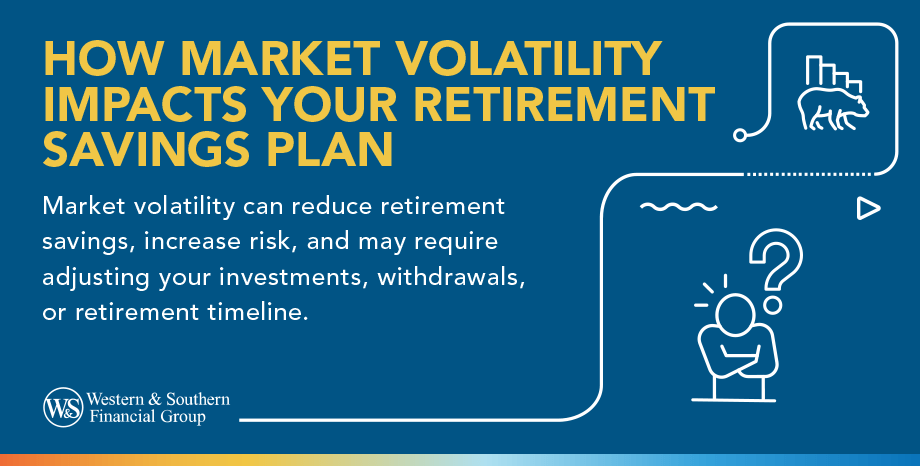

Key Takeaways
- Market volatility causes unpredictable price swings influenced by economic and geopolitical factors.
- Retirement savings can suffer from volatility, especially due to timing and sequence of returns risk.
- Diversifying investments may help reduce risk and stabilize retirement portfolios.
- Using dollar-cost averaging, emergency funds, and rebalancing can manage market fluctuations.
- Adjusting retirement timing and withdrawals can help offset market downturns.
What Is Market Volatility?
Market volatility means unpredictable investment ups and downs, which can affect your portfolio. Economic trends, global events, or investor reactions may drive these shifts. Knowing how market swings impact retirement savings is important to staying financially secure. Working with a financial advisor can offer investment advice to help manage risks effectively.
How Does Market Volatility Affect Retirement Savings?
A volatile market can directly impact the value of your retirement assets, especially if you hold a significant portion in equities.
- Timing Risk: If you're close to retirement and the market dips, your portfolio may not recover in time, potentially affecting your retirement timeline and available income.
- Asset Class Impact: Stocks and mutual funds experience greater volatility, while bonds and fixed-income investments are typically more stable but still influenced by economic conditions. Investing in high-quality bonds can help balance risk.
- Sequence of Returns Risk: Withdrawing funds during a market downturn can rapidly deplete savings. A diversified portfolio with conservative investments can help mitigate this risk.
Common Causes of Market Volatility
Market volatility can be triggered by various factors, many of which are interconnected. Below are some of the most common causes:1
1. Economic Indicators
GDP growth, unemployment rates, and inflation, can influence investor sentiment. A weak job market or slowing economic growth can lead to uncertainty and increased volatility.
2. Geopolitical Events
Political instability, trade disputes, or global conflicts can directly impact the stock market. Investors react to uncertainty by adjusting their portfolios, leading to sharp price movements.
3. Interest Rate Changes
Like the Federal Reserve, central banks adjust interest rates to maintain economic stability. Higher rates increase borrowing costs, affecting corporate profits and market fluctuations.
4. Corporate Earnings Reports
Publicly traded companies release quarterly earnings reports, and unexpected positive or negative results can drive stock prices up or down.
5. Market Speculation and Investor Behavior
Investor sentiment is shaped by speculation, herd mentality, and market psychology. Panic or excessive optimism can lead to dramatic market swings.
6. Natural Disasters and Pandemics
Natural disasters and pandemics, such as COVID-19, can disrupt economies, causing market downturns and extreme volatility.
Why Market Volatility Matters for Retirement
Emotional and Financial Toll
Market fluctuations can impact investor behavior, and having a structured financial strategy may help maintain stability. Consulting a financial advisor can help you stay on track with a long-term strategy.
Long-Term Growth vs. Near-Term Stability
Retirement plans, such as 401(k)s and IRAs, are designed for long-term growth. Short-term drops may feel discouraging, but a well-balanced strategy accounts for market corrections. Combining growth investments (stocks) with stable assets (bonds, cash) helps protect your portfolio. Conservative investments, such as high-quality bonds, can also provide stability. Annuities can provide a predictable and sustainable income stream for retirement, subject to contract terms.
Assessing Your Risk Tolerance
Gauging Personal Risk
Risk tolerance is the level of variability in investment returns you’re comfortable with. Some people can stomach significant volatility for the possibility of higher gains, while others prefer steadier (though potentially lower) returns. Before making any substantial moves in your retirement savings plan, it’s important to understand your comfort with risk.
- Time Horizon: The longer you have until retirement, the more market swings you can typically endure.
- Emotional Response: If you lose sleep over a five-percent drop, you might need a more conservative allocation.
- Financial Situation: Consider debt, job stability, and other income sources when determining risk tolerance. A financial advisor or tax advisor can provide insights based on your unique circumstances.
Tailoring Asset Allocation
After identifying your risk tolerance, you can shape your asset allocation. A balanced portfolio usually involves different types of investments, which can help minimize the overall impact of market volatility. This mix and diversification across various sectors and regions form a strong foundation for weathering market downturns.
Strategies to Protect Your Retirement Savings
Market volatility is, in many ways, unavoidable. However, there are proactive steps you can take to minimize its impact on your retirement savings plan. Below are suggested tactics to help you protect your retirement savings.
1. Diversification and Asset Allocation
Diversification means spreading your investments across various asset classes—stocks, bonds, real estate, and cash—to avoid overreliance on a single sector or market. This approach mitigates risks because when one area underperforms, another may excel, helping to keep your overall portfolio more stable.
- Domestic and International Stocks: Exposure to both can even out returns.
- Bonds: Less volatile investments, particularly government or high-quality bonds.
- Alternative Assets: Real estate, commodities, or even REITs can offer additional layers of diversification.
- Annuities: Providing a steady income stream, annuities can be a useful tool for retirees seeking financial stability.
2. Dollar-Cost Averaging Benefits
Dollar-cost averaging (DCA) involves investing a fixed sum of money at regular intervals, regardless of market conditions. This strategy can lower your average cost per share over time, as you buy more shares when prices are low and fewer when prices are high.
- Example: If the market dips, your contribution buys more shares at a lower price, potentially boosting returns when the market recovers.
- Psychological Benefit: DCA reduces the urge to “time the market,” a notoriously difficult practice even for experts.
3. Keeping Adequate Emergency Funds
Having three to six months’ worth of living expenses in cash prevents the need to withdraw from individual retirement accounts during downturns. Consulting a financial advisor can help you determine the best savings approach.
4. Rebalancing During Turbulent Times
Rebalancing adjusts your portfolio to its target asset allocation when market changes occur. If stocks outperform and dominate your portfolio, you may use some stocks to purchase bonds or other assets. This regular process helps maintain your intended risk level.
Adjusting Your Retirement Timeline
As market volatility can create fluctuations in your portfolio’s value, it may need adjustments to target retirement. Here are some considerations to address potential changes in your investment scenario:
Early vs. Delayed Retirement
- Early Retirement: Leaving work too soon may strain your savings and trigger early withdrawal penalties. It also means relying on your retirement fund for a longer period, increasing the risk of running out of money. If market downturns occur early in retirement, they can have a lasting impact on your portfolio. A tax advisor can help you navigate the implications of early withdrawals and the impact of taxes on your savings.
- Delayed Retirement: Postponing retirement can bolster your retirement savings plan because you have more time to contribute and less time to depend on your savings. Delaying Social Security benefits can also lead to higher monthly payments.
Partial Retirement as an Alternative
For those who want to retire but are concerned about the impact of market volatility, partial retirement may be a viable option. Working part-time can provide additional income, allowing investments to continue growing while reducing withdrawal needs. Many retirees choose consulting, freelancing, or part-time roles in their field of expertise.
Adjusting Your Withdrawal Strategy
Market volatility can impact how you withdraw funds in retirement. Strategies such as the 4% rule or dynamic withdrawal methods can help retirees maintain financial stability. In certain markets, reducing withdrawals or relying on cash reserves can prevent unnecessary portfolio losses. A tax advisor can provide guidance on the most tax-efficient withdrawal strategy and help manage taxes on withdrawals from different accounts.
Conclusion
Market volatility is inevitable, but a solid investment strategy can help protect your retirement savings. Diversifying assets, sticking to long-term goals, and avoiding emotional decision-making are key to maintaining financial security. Consulting a financial advisor can help create a plan tailored to your needs while considering annuities and tax implications.
Learn how market volatility could affect your retirement savings. Start Your Free Plan
Frequently Asked Questions
Is market volatility good or bad?
What is an example of a volatile market?
How can you identify market volatility?
Sources
- Factors That Cause Market Fluctuation. https://www.investopedia.com/ask/answers/100314/what-are-key-factors-cause-market-go-and-down.asp.
- Market Volatility. https://www.wallstreetprep.com/knowledge/volatility/.











